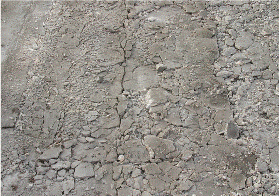9.3 Rubblizing
This process will completely fracture any type of PCC slab into pieces smaller than 1 ft.
2
and is very effective in breaking the bond of any reinforcing steel to the slab fragments. The slab is reduced to a high strength granular base that is not susceptible to transmitting reflective cracking through the HMA overlay. The fractured layer is typically compacted using a 10 ton vibratory roller. This is the preferred process for reducing JRCP and CRCP pavements. Rubblizing is typically done with one of the following two pieces of equipment:9.3.1 Resonant Pavement Breaker
This equipment strikes the rigid pavement at low amplitude with a small plate at the resonant frequency of the slab (usually about 44 Hz) causing the slab to break apart as shown in Figure 7-6. Usually, it takes about 14 to 18 passes for a resonant pavement breaker to rubblize an entire 3.6 m (12 ft.) lane (NCAT, 2001). Daily production rate is estimated to be about 6,000 yd.
2
/day. Figure 7-7 depicts broken pavement after using the resonant pavement breaker.
Figure 7-6. Resonant Pavement Breaker. © Copyright 2006 University of Washington

Figure 7-7. Rubblized pavement texture following resonant pavement breaking. © Copyright 2006 University of Washington